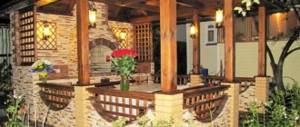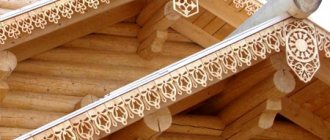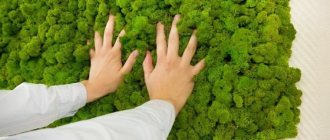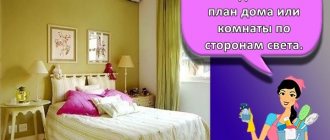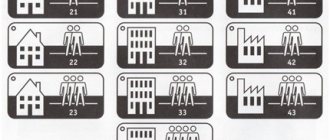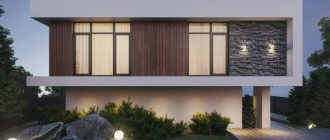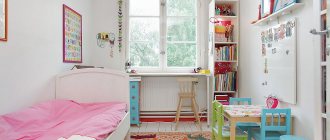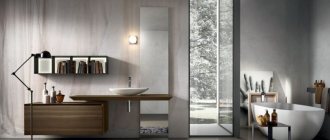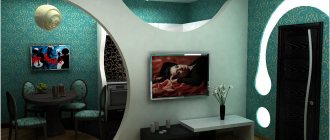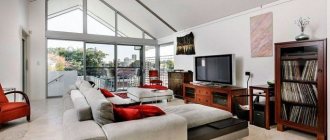Panels - cheap and practical
If you don’t have large financial reserves, but want to make your house attractive, then siding is the optimal solution. Initially, this name was given to ordinary wooden boards that were nailed to the facade so that the top layer hung over the bottom layer, creating a slight overlap. Thanks to this, water did not get under the boards and did not destroy the facade of the building. Now siding is a broader concept that includes finishing the facade of a private house with three types of panels made from the following materials: wood, metal, PVC (polyvinyl chloride). Let's look at each of the options offered by the modern market.
Wooden siding panels for finishing the facade of a house
Facing a private house with wooden siding will provide good thermal insulation and sound insulation, and a pleasant bonus will be the environmental friendliness of the material used. Cedar, oak or pine are used for production. Decorating the outside of a house with wooden panels is considered a beautiful and reliable option, since the material resists external factors and precipitation well. With all this, wood also has its drawbacks: it is demanding in terms of care and requires regular chemical treatment with antiseptics and impregnations. If you ignore this problem, the panels may rot, termites or other pests may infest them.
Cladding a private house with metal siding
Metal is the most practical material that is used in all areas of construction. Metal panels last a long time, do not require attention and look very beautiful and modern. By combining metal with stone you can create a truly chic facade that will attract the attention of friends and relatives. The panels are based on steel or aluminum.
PVC panels for facade finishing
Polyvinyl chloride panels are a material that does not require careful monitoring and maintenance, and is actively used for cladding both private and industrial buildings. The reason for its popularity is its low price and good performance. The modern construction market offers many color and style solutions; the material can easily imitate more expensive natural materials (stone, brick, wood, etc.). The advantages of vinyl panels include high-quality insulation, but the disadvantage is poor resistance to mechanical loads (with a pinpoint impact, the material cracks, and with strong temperature changes it can become deformed).
Types of modern materials for finishing house facades
The construction and subsequent finishing of the facade of one-story residential buildings today can be performed with a variety of materials for external work. They have unique properties, individual service life, unique aesthetics, relevance of application, and level of care requirements. The technologies for using each of them in practice also differ from each other, which is important to consider when selecting a specific material.
Decorative plaster
Decorative plaster is very often used to decorate the external walls of private buildings these days. These unique mixtures provide a person with the opportunity to realize the most non-standard design fantasies and give the house an interesting, original look. Decorative facade plaster is distinguished by a wide selection of color shades, textures, and methods of application to the base.
Today on the shelves of construction stores you can find several types of decorative plaster mixtures, with which you can create a unique project for the facade of a house:
- mineral;
- silicate;
- acrylic;
- silicone.
Acrylic Mineral Silicate Silicone
Different types of decorative plaster mixtures demonstrate different properties: the level of sound and heat insulation ability, resistance to negative factors: fire, precipitation, ultraviolet study, and so on. Therefore, the owner of the building has the opportunity to choose the most suitable option for the conditions of the specific area where the house is located.
The installation of plaster is characterized by certain specifics, depending on the type of mixture chosen, as well as the nature of the base. The stages of work are as follows: preparing the base, priming it, installing beacons, spraying the first layer of the mixture, installing the reinforcing mesh, organizing the second layer of the mixture, grouting and giving the base a specific texture, painting the facade.
Particularly popular today is the bark beetle facade, which is distinguished by its unique aesthetics, originality, and non-standard appearance. Externally, the facade takes on the appearance of a surface that has been corroded by the bark beetle. The specifics of working with a bark beetle are quite simple: the effect is achieved through the use of a grater, as well as the choice of a specific direction in the process of grinding dried material. The project for decorating a residential building with bark beetle is shown in the photo below: its high aesthetics, conciseness and originality are difficult not to appreciate.
Clinker bricks and tiles
Clinker bricks and tiles demonstrate extraordinary strength and resistance to negative environmental factors. Modern house finishing with clinker will not be cheap, but such options can provide the external walls of the building with reliable protection for many decades. The project for finishing the facade of a private cottage with clinker is shown in the photo below.
Clinker bricks and tiles are created using a unique technology using environmentally friendly raw materials, so such finishing materials in no way harm human health or the environment.
Today, construction and finishing work in the private sector outside of large cities is actively carried out using clinker, the design styles of which can be varied. Such facades are able to imitate the aesthetics of other types of materials. For example, they are made in the same shape and color as brick, natural stone and the like.
Therefore, with its help, you can give a building a varied look and high aesthetics, successfully integrating the curtain façade into the surrounding landscape. It is worth noting the easy installation of this material, which can be handled even by a person without much experience in construction work.
Clinker brick
Tile
Porcelain tiles
In previous years, such finishing materials were used for cladding horizontal and vertical planes on the ground floor of houses: plinths, steps, door and window openings. Today, it is used to decorate garages, swimming pools, and facades of private houses.
This is a very durable finish. The moisture resistance and strength of porcelain stoneware, its resistance to sudden changes in temperature, and aesthetic qualities are very high. The color possibilities of porcelain stoneware are very wide: such materials provide the buyer with a wide choice of shades, and there are also a variety of styles in which they can be applied. The project for the facade of a country house made of porcelain stoneware is presented in finished form in the photo below.
Today, the most popular options for such cladding for private buildings are as follows:
- structured - a facade project with such cladding has the most presentable appearance, since the material is able to imitate any texture. For example, wood, stone, leather or fabric;
- processed varieties: glazed, polished, satin and matte tiles.
Installation of porcelain stoneware on the facade of a home is carried out in the following sequence of operations:
- leveling the surface of the base, eliminating existing stains, cracks, chips, priming the facade;
- coating the base with an adhesive composition;
- numbering of porcelain stoneware slabs, their alternate installation on the wall;
- rubbing end joints and joining tongue and groove joints.
Facade cassettes
A facade cassette is a panel made of durable metal, inside of which a filler with specific properties is placed. This type of cladding is often rectangular in shape and made of aluminum, steel, and so on.
In order for the curtain wall to become highly resistant to various destructive influences, its surface is coated with zinc, special polymer compounds, and polyesters.
To understand what a house with such cladding looks like, pay attention to the photo below. Installation of metal cassettes on the outside of the walls is carried out using substructure elements. The operation design is simple. But first, the walls are thoroughly cleaned of the previous finish, and they are leveled only if there is a significant deviation from the vertical. If the surface of the outer wall has no defects, there is no need to level it. The design styles of such finishing are very diverse.
A curtain wall façade with metal cassettes allows, if desired, to fill the space between the walls and the cladding with heat-insulating boards, fixing them with disc-shaped dowels. Therefore, buildings finished with metal cassettes and insulating material can become warm, cozy and durable.
Siding
The project of finishing the outer wall of country houses with siding has become popular in the domestic market quite recently. This trend is explained by many positive parameters of the material: low cost, excellent strength and a large selection of color shades.
Thanks to the wide variety of colors, shapes, and textures of siding, owners of residential buildings can give them the most unimaginable design with unique properties. It is difficult to find two completely identical buildings that are finished with siding.
Installation of siding for the external walls of buildings is not complicated by difficulties, since the material is easy to install, and the project provides for the work to be completed in a short time. This finish can be used for walls made of different building materials, timber, brick. Finishing the facade of a wooden house with siding looks absolutely unsurpassed, laconic and attractive, as confirmed by the photo below.
Natural and artificial stone
Natural stone of various shapes has long been used to organize the facades of buildings for various purposes. Construction today uses it very widely, because the material has unique properties: high durability, resistance to mechanical stress, high humidity, sunlight and other factors that have a destructive effect on the walls of the house. To see the high aesthetics of residential buildings with natural stone cladding, pay attention to the photo below. It is actively used by many styles in facade design.
The main disadvantages of a facade project using such material for exterior wall decoration are its high cost, as well as the significant weight of the cladding. Therefore, natural stone has limitations in its scope of application. The technology does not imply its use for finishing a frame house with thin walls.
An equally successful option for organizing the facade of a residential building is finishing with artificial stone of various shapes. The project can be varied, as shown in the photo below. Natural materials are much more expensive than artificial stone, but, as practice shows, its performance parameters are no less high.
Panels
Such options for organizing the facades of residential buildings are distinguished by high performance parameters and a unique appearance. With the help of such material, you can give a private home high aesthetics and an expensive appearance, which is confirmed by the photo presented to the reader below. A curtain façade of this kind can be installed quite quickly and easily: the operating technology is simple and can be carried out even by a person without experience in such matters.
| Species diversity | pros | Minuses |
| Made of metal with polymer coating | Long service life, resistance to ultraviolet radiation, temperature changes | Low thermal insulation properties |
| Wood fiber panels | Natural, environmentally friendly, light weight | High flammability and tendency to swell from moisture |
| Vinyl | Practical, light weight | Brittleness at low temperatures |
| Thermal panels | Light weight, high frost resistance | Toxicity of components |
| Sandwich panels | Light weight, wear resistant | Fragility if handled carelessly |
| Fiber cement facade systems | Self-cleaning ability, high frost resistance, durability, strength | Low impact resistance, high water absorption |
| Made of stone and porcelain stoneware | High frost resistance | High cost, significant weight |
| Glass panels | Wear resistance, original aesthetics | Difficult installation, expensive |
That is, the design of such cladding is very diverse, which expands the decorative styles in which it is relevant.
Wooden
Fiber cement
Sandwich panels Metal
Glass panels Thermal panels
Wet facade
The wet method of finishing facades has gained respect among owners of private houses due to the minimal number of cold bridges characteristic of alternative cladding methods. But this is not the main advantage of a wet facade. It is also worth noting the fact that such finishing helps to move the dew point beyond the boundaries of the living space. Therefore, the problem of condensation is eliminated when there is a large difference between indoor and outdoor temperatures.
Installation of a wet facade requires certain skills from a person. It involves the following operations: preparing the base, installing profiles, thermal insulation, reinforcing the base, organizing a layer of plaster mixture, giving the layer of plaster mixture the actual texture (for example, using a trowel if bark beetle finishing is used), painting the dried plaster mixture. In this case, it is very important to select the type of plaster mixture for the outer layer, since the finish must have high vapor permeability and resistance to wear.
Note that a wet facade can be created using other materials for the outer layer: siding, facade panels, and so on. The photo below shows a façade with a wet finish.
Cladding the facade of a private house with brick
Brick is an ideal material for finishing the facade of a house, with which you can make patterns, change the appearance of the house and make it deeper. Brick is a relatively light, durable, easy-to-install, high-quality material that does not require attention and also guarantees good sound and heat insulation. A house with brick finishing is the optimal solution for those who do not have enough money to build a full-fledged brick house. This material will make the facade not only beautiful, but also reliably protected, and the only disadvantage of the material will be the price, which is slightly higher than that of the panel.
How to additionally decorate the facade of the house?
If your goal is a beautiful, but moderately bright home, try to avoid extravagant decor for the facades.
A sign with the house number will be a wonderful decoration for the exterior - the numbers on it can be printed in an unusual font or colored paint. A mailbox, a rug at the front door, lighting - all these little things create a certain character and mood. Before the New Year holidays, decorate your home with lights and other holiday decor. And don’t forget to use photos of finished projects for inspiration when updating the facade of your house. If you are just looking for ideas for renovation and improvement or already know for sure that a house is your option, we have collected for you 1,199,887 photos from real projects of interior designers, decorators and architects from Russia and around the world, including such proven professionals as Kerimov Architects and Alexander Mochalov. The beautiful houses in our photographs are the best examples of competent design and layout in different styles and colors. If you like any design option, for example the house from the second photo, you can contact the author and order the ideal design project for yourself. See our photo gallery, look for inspiration and professionals, and you will see why Houzz is the best resource for apartment and home interior design, renovation, home construction, architecture and landscape design.
Decorating the outside of the house with natural stone
Natural stone is one of the most expensive materials that can be used for cladding the outside of a private house. In addition to large financial investments, the stone will require the activation of huge labor resources. Cladding a private house with natural stone is a long and extremely complex process that only real professionals can handle, but you need to be prepared for the fact that the price for their services will be appropriate. This material is not used often, since the price deters many, however, if you decide to create an ideal home, a palace for the future generation, then stone is the best solution for realizing your idea.
Advice! When planning the decoration of the facade, it is necessary to focus on the interior of the building, since the external and internal appearance of a private house should interact with each other and not contradict themselves. Dissonance between the exterior and interior of a home will destroy a pleasant impression even if a lot of money is spent on finishing work.
What a perfect façade he is.
Not all materials are suitable for exterior decoration of a house. After all, the outer facing layer takes on all the loads: the influence of weather conditions, temperature changes, scorching sun, wind, pressure from supporting structures and much more.
In order to adequately withstand all of the above factors, the exterior finishing must have a number of special qualities:
- The facade must be beautiful, because it is the face of a private house. The appearance of the finish must be in harmony with the surrounding area and the structure of the building.
- The finishing must be durable, because it simply must last at least 15-20 years in order to be replaced during the next major renovation of the house.
- Weather conditions such as frost, extreme heat, rain, snow and wind are not dangerous for high-quality finishing of facades. The wall covering should not crack, peel, lose its visual appeal, fade, etc.
- It is desirable that the facade covering material has the ability to “breathe”, that is, it is breathable. If the chosen finish does not have this quality, you will have to arrange ventilation for the facade, which means additional costs and time.
- A good facade plays the role of insulation; it retains heat without releasing it beyond the walls of the house. Modern finishing materials, as a rule, meet such thermal requirements.
- Under no circumstances should the façade finish burn or release toxic substances during the melting process - the safety of the residents of the house depends on this.
- The finishing material should not harbor microorganisms, fungi or insects. After all, it is mold, bug passages and other troubles that become the root cause of the appearance of microcracks, and subsequently the complete destruction of the facade.
Attention! Since almost every house has the ability, over time, to shrink and slightly change its geometry, the facade finishing must be tear-resistant, that is, a little plastic. As a result, such a facade will compensate for small cracks or subsidence of the walls.
Concrete is a modern finishing material
In Russia, concrete as a type of facing material is only gaining popularity, but in European countries it has been used for many years. Thanks to concrete, you can strengthen the structure of the building and create a modern exterior of a private house. For the combination you need to use metal and a lot of glass, so the house will look stylish and fashionable. Although concrete is considered a rough material, when combined with wood it becomes much softer, emphasizing the dignity of wood, acting as a decorative element.
Decorative siding
Production of materials has increased. They can have a natural or artificial base. It is important to know their quality. It will be difficult to understand them without knowledge. Any information will help you understand where to choose. The more we talk about this topic, the easier it is to choose material for the exterior.
Vinyl siding
Vinyl siding is increasingly being chosen for facade design. What makes it popular is its beautiful, strict appearance and variety of shapes. The variety of colors allows you to fantasize. Its complex composition makes it reliable, strong, and resistant to weather changes. These characteristics extend the service life.
Compound:
- Polyvinyl chloride (PVC) is the basis, occupies 75-80% of the total. Present only in the lower layers. Manufacturers often use recycled materials, which affects the quality of production.
- Calcium carbonate - entered the base of the lower layer by 15%. Helps fill out the sheet structure.
- Titanium dioxide is a white powder, 10% included in the composition. It stabilizes the structure, makes it possible to maintain the brightness of colors and resistance to ultraviolet rays.
- Butadiene – serves as a composition stabilizer, no more than 1%.
- Paint pigments are a component that creates opacity in a material and gives a tint.
- Modifiers - make raw materials more resistant to weather changes and natural conditions. Thanks to them, he becomes reliable.
- Lubricating element - required for ease of sheet sliding and protection from defects. The product looks smoother.
Types:
- Basement siding is thick, with a denser structure, most often imitating stone, brick, marble, granite.
- Soffit - strips that are used for horizontal surfaces, roofing work carried out on a slope, as well as for covering gazebos. Can be smooth, perforated or mixed. Has a wide color spectrum.
- Vinyl siding (smooth panels, with an angular profile, fastened with double or triple herringbone).
- Wall siding has a smooth surface and an angular profile. It is attached at an angle, in the form of a single, double or triple herringbone or shipboard.
Attention!
To work with artificial stone, you will need a large amount of special glue. If there is not enough of it, it may fall off.
Wood siding
Using panels that imitate wood would be an excellent solution. The facing materials are of very high quality. Muted tones, close to the colors of nature, delight the eye.
Characteristics:
- beauty;
- reliability;
- strength;
- low heat transfer;
- moisture resistance;
- resistance to frost and summer heat;
- ease of installation.
Wood is used for production. The raw materials are crushed and mixed with artificial materials. The products are then pressed under high pressure. The only disadvantages will be its fire hazard and the possibility of deformation. The material requires further processing.
Metal siding
Suitable for exterior decoration of a country house. Protects from any weather. The facade of the house is easy to make with your own hands. When working, the material does not require special skills. Protects living space from fires, bad weather and precipitation.
Comprises:
- polymer outer layer;
- steel sheet;
- conversion layer;
- zinc layer;
- protective coating (paint coating).
- The multicomponent composition makes it more reliable.
The material has the following characteristics:
- strength;
- moisture resistance;
- fire resistance;
- fungal resistance;
- resistance to sunlight and frost.
They make metal siding very high quality and popular.
Flaws:
- fast heating;
- impossibility of recovery during deflection.
The low price attracts buyers, but we must remember that repairs can be much more expensive. Externally, siding can resemble wood, brick, natural stone, timber. The houses, examples of which are shown in the photo, look as if they are upholstered in natural materials.
Cement siding
This beautiful coating does not fade in the sun, does not rust, and is resistant to weather changes. It has a wide selection of colors: bright, pastel, natural. Created on the basis of fiber cement, it is a leader in sales. It has reliable characteristics:
- invulnerable to weather conditions;
- refractory;
- moisture resistant;
- resists the appearance of fungi;
- keeps warm.
Before use, you must warn the builders, since the walls of a one-story or two-story house must be very strong.
Attention!
Vinyl siding does a good job of hiding uneven exterior walls and hiding pipes and communications. This type of cladding is considered “breathable”.
Facade siding
Decorative siding is one of the most popular facing materials. It is inexpensive, has excellent decorative qualities and simple installation. In addition, facades covered with siding are very durable (up to 50 years) and retain heat well. Siding is often used to decorate very old houses - the structure is instantly transformed.
There are several types of exterior sidings:
- Initially, walls began to be finished with vinyl siding, which can imitate almost any surface (from wood to natural stone). It is difficult to be disappointed in this finishing material, because it is cheap, but resistant to external factors, very durable, and easy and quick to install.
- You can decorate the simplest house with wooden siding, and it will look like an expensive natural log house. This cladding is made for facades made of wood: boards or timber. The facades turn out beautiful, they do not require additional insulation, but the wooden finish will not last long.
- Another facade material is metal siding. These are steel sheets coated with a thin layer of zinc or colored polymers. The facades turn out beautiful, serve for a long time and are well maintained, but they do not retain heat and allow extraneous sounds into the house.
- Cement siding is produced by pressing cellulose and cement. The performance qualities of this finish are equal to stone. Siding does not burn, but it is heavy and difficult to install on facades.
Attention! Facade material such as siding is usually installed in a ventilated manner, since it does not allow air to pass through.
Photos of house facades with your own hands
Read here - How to make a heated floor with your own hands: step-by-step description, diagrams, rules and methods for arranging heating elements (120 photos and videos)
Facade plasters
One of the most ancient methods of exterior decoration is plastering walls. Modern facade plaster has a lot of useful properties, protects walls well from external factors and decorates any building.
Facade plaster has many advantages:
- quickly improve the appearance of a private home;
- the ability to paint plaster in any shade;
- moisture resistance;
- resistance to ultraviolet radiation;
- ability to withstand frost and heat;
- good thermal insulation qualities;
- vapor permeability, that is, the ability to “breathe”;
- ease of installation and low cost.
Attention! Plaster will not protect walls from impacts and other mechanical damage. This finish is quite fragile and must be treated with care.
A natural stone
This coating looks luxurious and reliable. However, before purchasing such finishing materials, you must take into account that they are quite heavy.
Therefore, you first need to assess whether the foundation will withstand such heavy loads. If necessary, walls and foundations should be strengthened.
Finishing a facade using such material requires certain skills and experience. It is much simpler and easier to cladding the facade using an artificial analogue.
Check it out here too!
Do-it-yourself countertop installation: selection, installation and fastening of the countertop. 155 photos of the best ideas and tips for their use
- Do-it-yourself canopy - beautiful ideas, best projects and tips on how to build a canopy with your own hands (90 photos and videos)
Do-it-yourself siding installation: stages of the work, step-by-step instructions for installing the siding and secrets of choosing high-quality siding (125 photos and videos)
This coating has excellent technical characteristics and is practically no different in appearance from natural stone.
In addition, the weight of such material is much less and the cost is much lower.
